Simulation and Experimental Investigation of Granular Medium Forming Technology on Titanium Alloy Sheet at 500 °C
Abstract
1. Introduction
2. Coupled Eulerian–Lagrangian Simulation and Analysis of the GMF Process
2.1. Coupled Eulerian–Lagrangian Simulation Modeling
2.2. Calculation Results and Deformation Analysis of the CEL Algorithm at Room Temperature
3. Experimental Investigation of the GMF Process
3.1. Mold Design for the GMF Process
3.2. Experimental Equipment and Setup
3.3. Experimental Results and Analysis
3.3.1. GMF Experiment of Titanium Alloy Sheet at Room Temperature
3.3.2. Evaluation of the Calculation Accuracy of the CEL Algorithm at RT
3.3.3. GMF Experiment on TA1 Sheet at 500 °C
3.3.4. GMF Experiment on the TC4 Titanium Alloy Sheet at 500 °C
3.3.5. Analysis of the Calculation Accuracy of the Viscoplastic Model
4. Conclusions
- (1)
- The results of the GMF experiment on a TA1 titanium alloy sheet at RT showed that the bottom of the formed parts had a cambered surface with good external surface quality. During the deep drawing processing, the sheet was acted on by normal stress in the thickness direction, which greatly reduced the wrinkling tendency of the parts.
- (2)
- The GMF experiment on the TA1 sheet at 500 °C was conducted using three different types of punch lock blocks, and the results showed that the pressure distribution of the granular medium could be improved by using a punch lock block with a convex surface, which could also improve the formability of the sheets.
- (3)
- The results of the GMF experiment on the TC4 titanium alloy sheet at 500 °C showed that the contour curvature of the deformation zone at the bottom of the parts increased with a reduction in the yield strength of the blank, and, under the same drawing force, the drawing depth increased with a reduction in the yield strength of the blank.
- (4)
- Compared with the experimental results, an analysis of the accuracy of the calculations of three established analysis models showed that GMF technology could improve the forming properties of titanium alloy sheets at 500 °C.
Author Contributions
Funding
Conflicts of Interest
References
- Zhao, C.C.; Li, X.D.; Dong, G.J.; Wang, Y.S. Solid granules medium forming technology and its numerical simulation. J. Mech. Eng. 2009, 45, 211–215. [Google Scholar] [CrossRef]
- Zhao, C.C.; Wang, Y.S.; Li, X.D.; Dong, G.J.; Liu, S.B. Solid granules medium forming technology and theoretical research. J. Plast. Eng. 2007, 14, 54–59. [Google Scholar]
- Dong, G.J.; Zhao, C.C.; Cao, M.Y. Flexible-die forming process with solid granule medium on sheet metal. Trans. Nonferr. Metals Soc. China 2013, 23, 2666–2677. [Google Scholar] [CrossRef]
- Liu, K.N.; Lang, L.L.; Zhang, W.S.; Marai, M.; Liu, B.S. Coupled Eulerian–Lagrangian simulation of granular medium sheet forming process and experimental investigation at elevated temperature. Int. J. Adv. Manuf. Technol. 2017, 88, 2871–2882. [Google Scholar] [CrossRef]
- Lang, L.L.; Liu, B.L.; Li, T.; Zeng, Y.S. Experimental investigation on hydromechanical deep drawing of aluminum alloy with heated media. Steel Res. Int. 2012, 83, 230–237. [Google Scholar] [CrossRef]
- Turkoz, M.; Cora, O.N.; Gedikli, H.; Dilmec, M.; Halkaci, H.S.; Koc, M. Numerical optimization of warm hydromechanical deep drawing process parameters and its experimental verification. J. Manuf. Process. 2020, 57, 344–353. [Google Scholar] [CrossRef]
- Cai, G.S.; Yang, J.L.; Yuan, Y.F.; Yang, X.Y.; Lang, L.H.; Alexandrov, S. Mechanics analysis of aluminum alloy cylindrical cup during warm sheet hydromechanical deep drawing. Int. J. Mech. Sci. 2020, 174, 105556. [Google Scholar] [CrossRef]
- Cai, G.S.; Fu, J.B.; Zhang, D.X.; Yang, J.L.; Yuan, Y.F.; Lang, L.H.; Alexandrov, S. A novel approach to predict wrinkling of aluminum alloy during warm/hot sheet hydroforming based on an improved Yoshida buckling test. Materials 2020, 13, 1165. [Google Scholar] [CrossRef]
- Dasappa, P.; Inal, K.; Mishra, R. The effects of anisotropic yield functions and their material parameters on prediction of forming limit diagrams. Int. J. Solids Struct. 2012, 49, 3528–3550. [Google Scholar] [CrossRef]
- Qiu, G.; Henke, S.; Grabe, J. Application of a Coupled Eulerian–Lagrangian approach on geomechanical problems involving large deformation. Comput. Geotech. 2011, 38, 30–39. [Google Scholar] [CrossRef]
- Grüner, M.; Merklein, M. Numerical simulation of hydroforming at elevated temperatures with granular material used as medium compared to the real part geometry. Int. J. Mater. Form. 2010, 3, 279–282. [Google Scholar] [CrossRef]
- Chen, H.; Güner, A.; Khalifa, N.; Tekkaya, A.E. Granular media-based tube press hardening. J. Mater. Process. Technol. 2016, 228, 145–159. [Google Scholar] [CrossRef]
- Huang, C.Q.; Liu, L.L. Application of the constitutive model in finite element simulation: Predicting the flow behavior for 5754 aluminum alloy during hot working. Metals 2017, 7, 1–12. [Google Scholar]
- Cao, M.Y.; Dong, G.J.; Zhao, C.C. Research on Pressure-transfer Characteristics in the Solid Granule Medium Forming Based on the Discrete Element Method. J. Mech. Eng. 2011, 47, 62–69. [Google Scholar] [CrossRef]
- Mei, H.; Lang, L.L.; Liu, K.N.; Yang, X.G. Evaluation study on iterative inverse modeling procedure for determining post-necking hardening behavior of sheet metal at elevated temperature. Metals 2018, 8, 1044. [Google Scholar] [CrossRef]
- Liu, K.N.; Lang, L.L.; Cai, G.S.; Yang, X.Y.; Guo, C.; Liu, B.S. A novel approach to determine plastic hardening curves of AA7075 sheet utilizing hydraulic bulging test at elevated temperature. Int. J. Mech. Sci. 2015, 100, 328–338. [Google Scholar] [CrossRef]
- Grüner, M.; Merklein, M. Influences on the molding in hydroforming using granular material as a medium. AIP Conf. Proc. 2011, 1383, 645–652. [Google Scholar]
- Lade, P.V.; Yamamuro, J.A.; Bopp, P.A. Significance of particle crushing in granular materials. Am. Soc. Civil. Eng. 2014, 122, 309–316. [Google Scholar] [CrossRef]
- Yang, Z.Y.; Zhao, C.C.; Dong, G.J.; Du, B.; Zhang, L. Analytical model of corner filling with granular media to investigate the friction effect between tube and media. Int. J. Adv. Manuf. Technol. 2018, 99, 211–224. [Google Scholar] [CrossRef]
- Luo, K.; Zhang, L.; Wu, G.H.; Liu, W.C.; Ding, W.J. Effect of Y and Gd content on the microstructure and mechanical properties of Mg-Y-RE alloys. J. Magnes. Alloy. 2019, 7, 345–354. [Google Scholar] [CrossRef]
- Yuan, L.H.; Gu, D.D.; Lin, K.J.; Ge, Q.; Shi, X.Y.; Wang, H.R.; Hu, K.M. Influence of structural features on processability, microstructures, chemical compositions, and hardness of selective laser melted complex thin-walled components. Int. J. Adv. Manuf. Technol. 2020, 109, 1643–1654. [Google Scholar] [CrossRef]
- Hu, M.; Dong, L.M.; Zhang, Z.Q.; Lei, X.F.; Yang, R.; Sha, Y.H. Correction of flow curves and constitutive modelling of a Ti-6Al-4V alloy. Metals 2018, 8, 1. [Google Scholar] [CrossRef]
- Al-Badour, F.; Merah, N.; Shuaib, A.; Bazoune, A. Coupled Eulerian Lagrangian finite element modeling of friction stir welding processes. J. Mater. Process. Technol. 2013, 213, 1433–1439. [Google Scholar] [CrossRef]
- Ansari, M.A.; Samanta, A.; Behnagh, R.A.; Ding, H.T. An efficient coupled Eulerian-Lagrangian finite element model for friction stir processing. Int. J. Adv. Manuf. Technol. 2019, 101, 1495–1508. [Google Scholar] [CrossRef]
- Arienti, M.; Hung, P.; Morano, E.; Shepherd, J. A level set approach to Eulerian-Lagrangian coupling. J. Compt. Phys. 2003, 185, 213–251. [Google Scholar] [CrossRef]
- Cirak, F.; Radovitzky, R. A Lagrangian-Eulerian shell-fluid coupling algorithm based on level sets. Comput. Struct. 2005, 83, 491–498. [Google Scholar] [CrossRef]
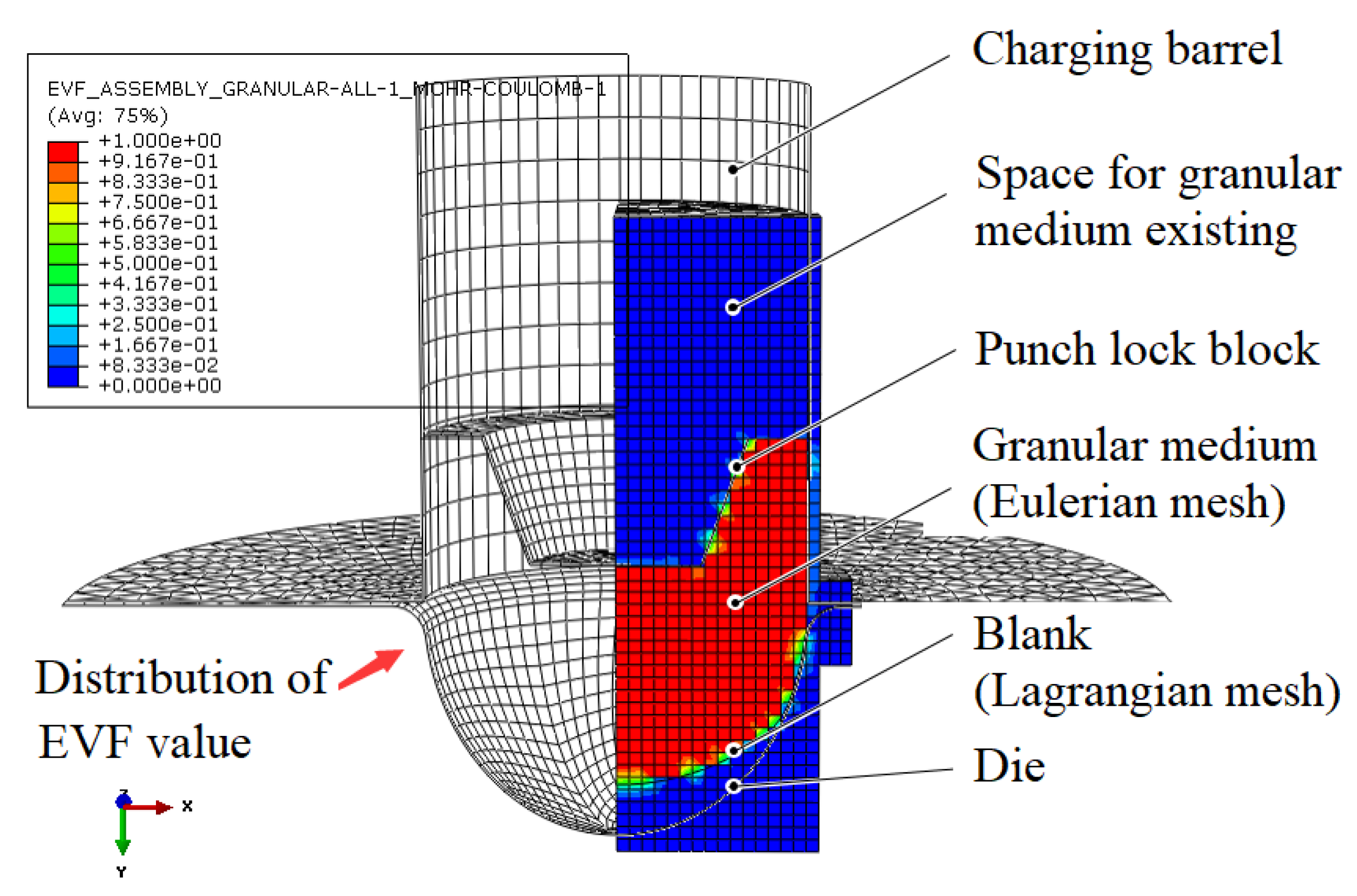
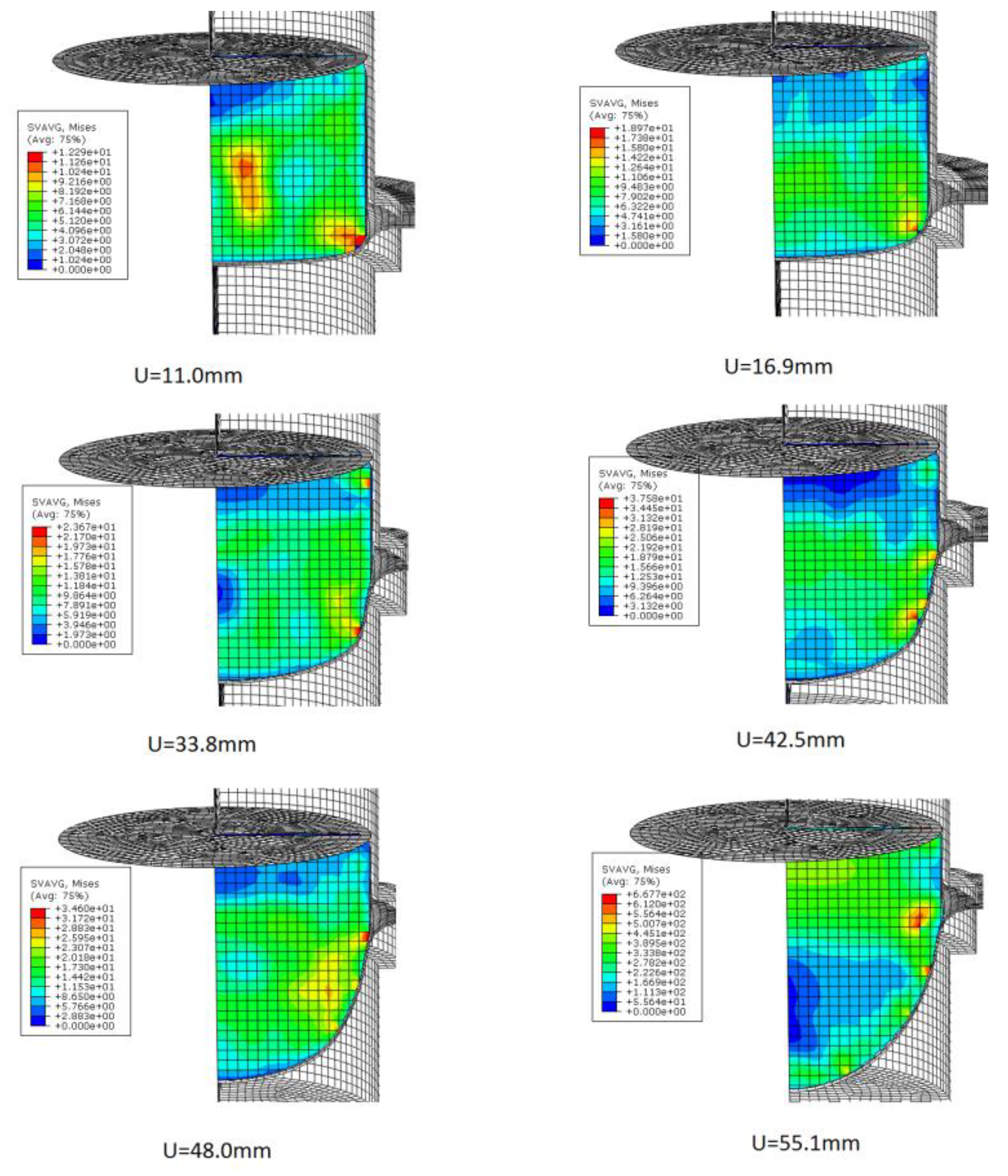
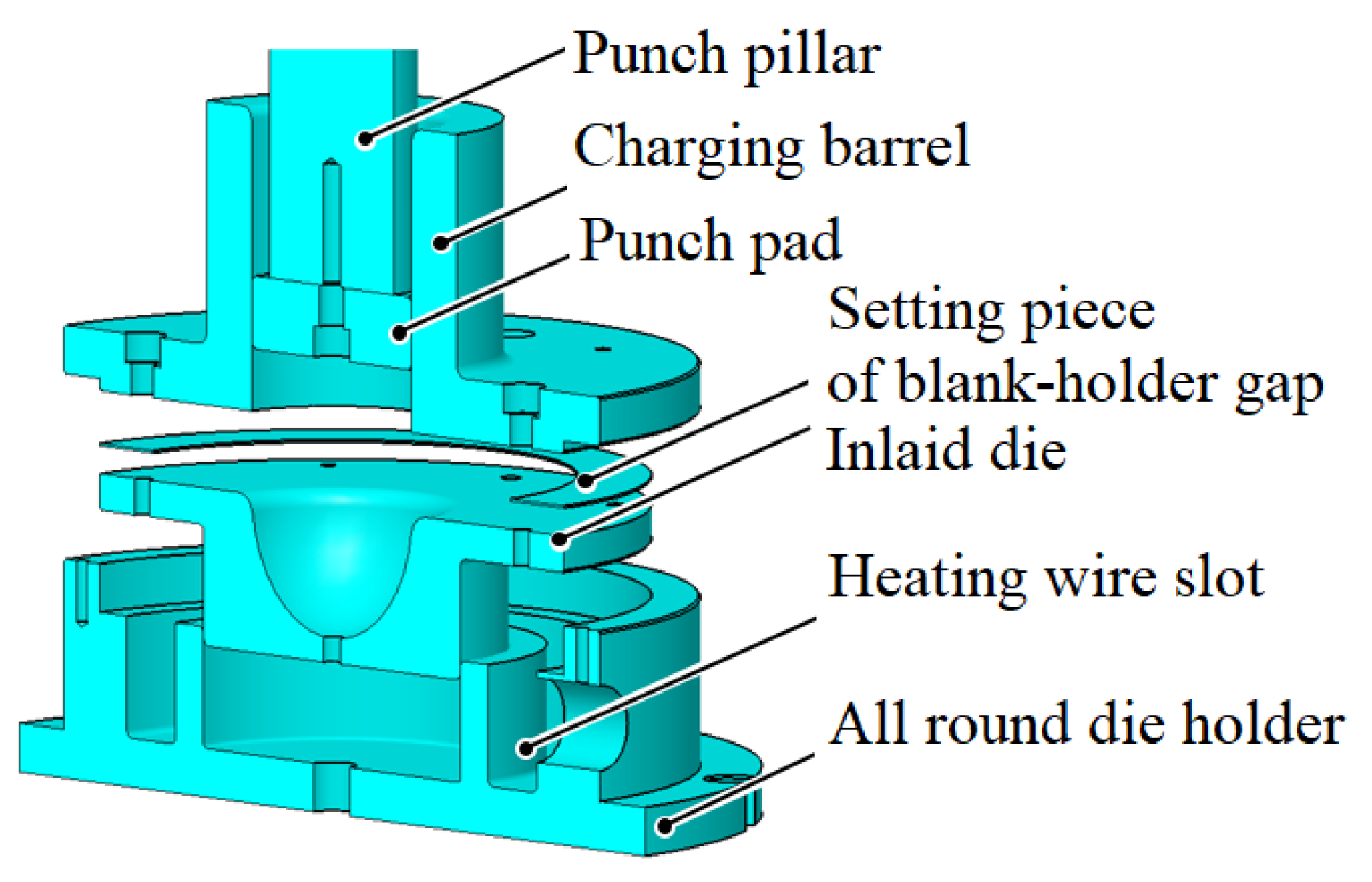
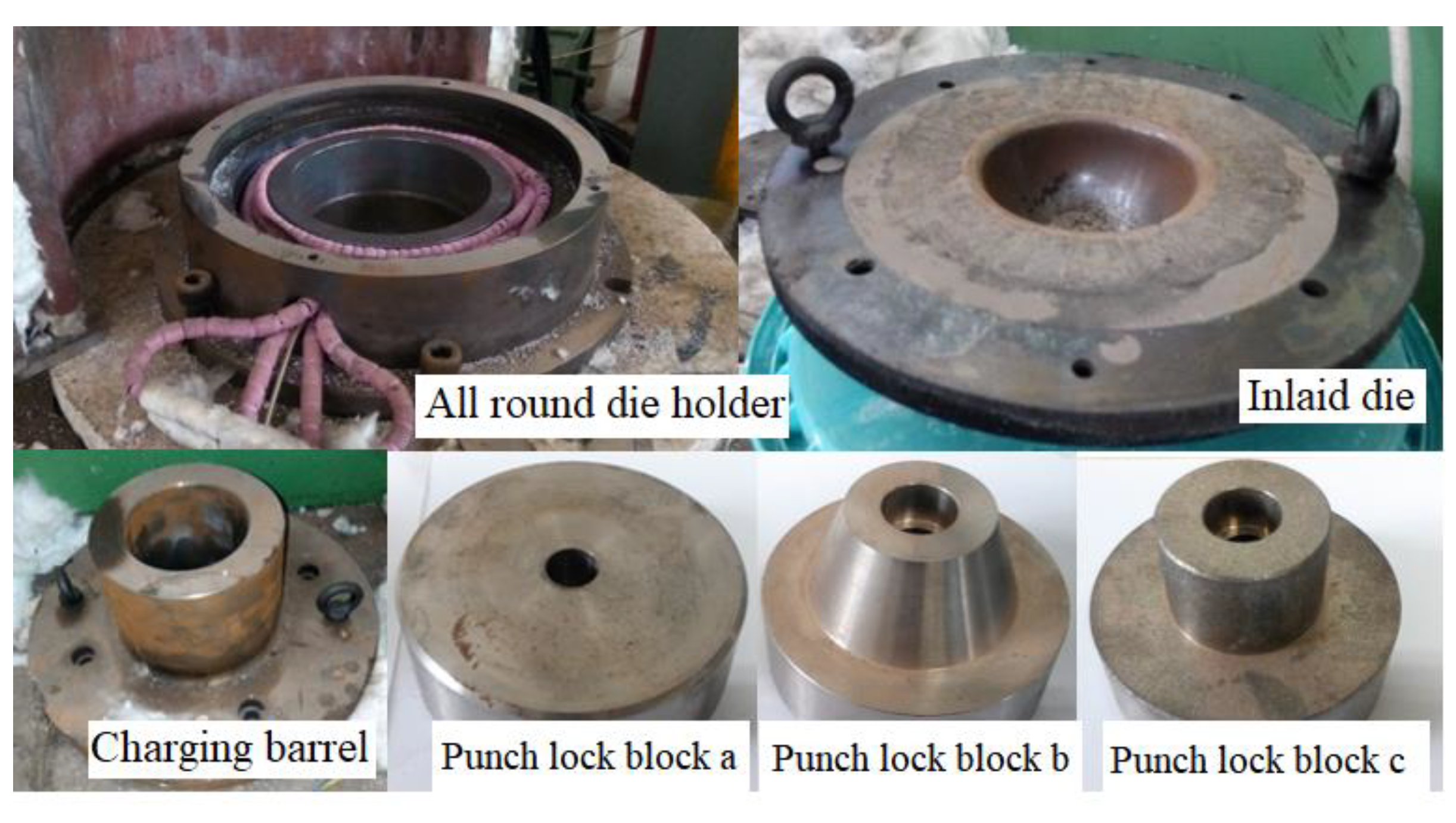



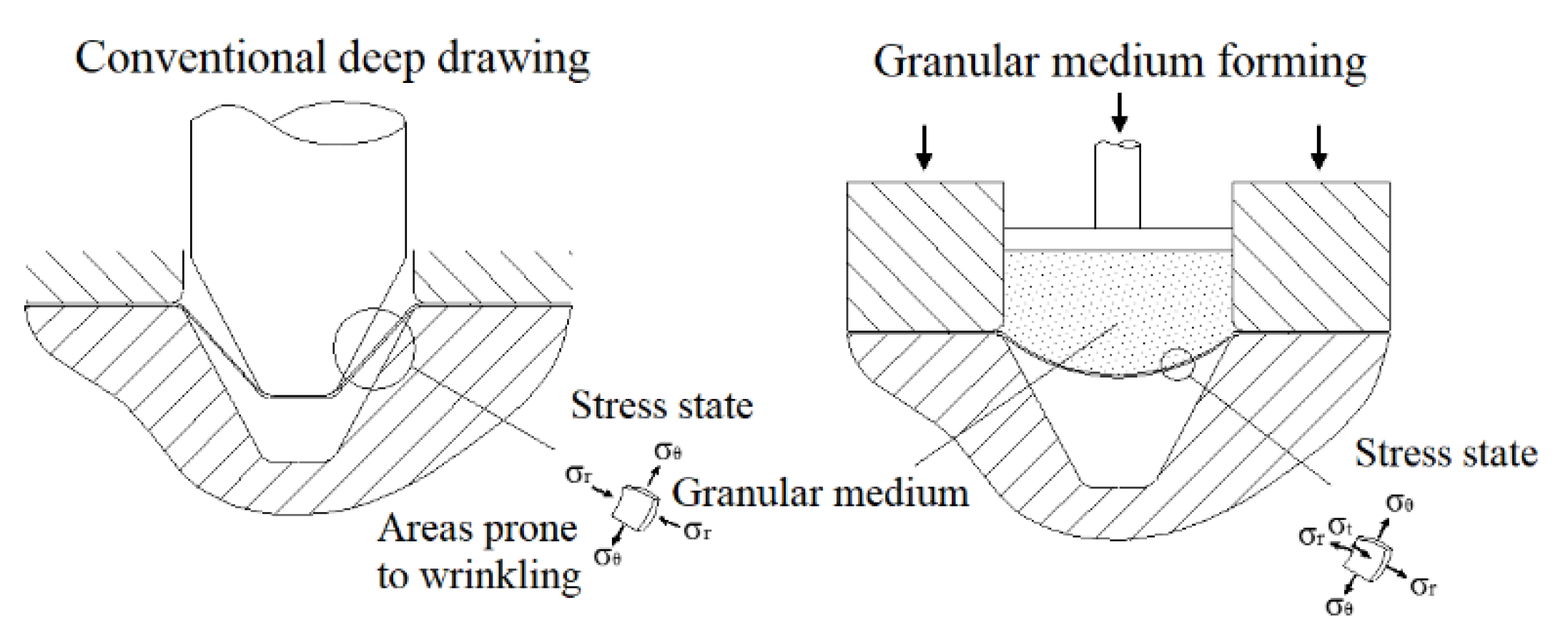
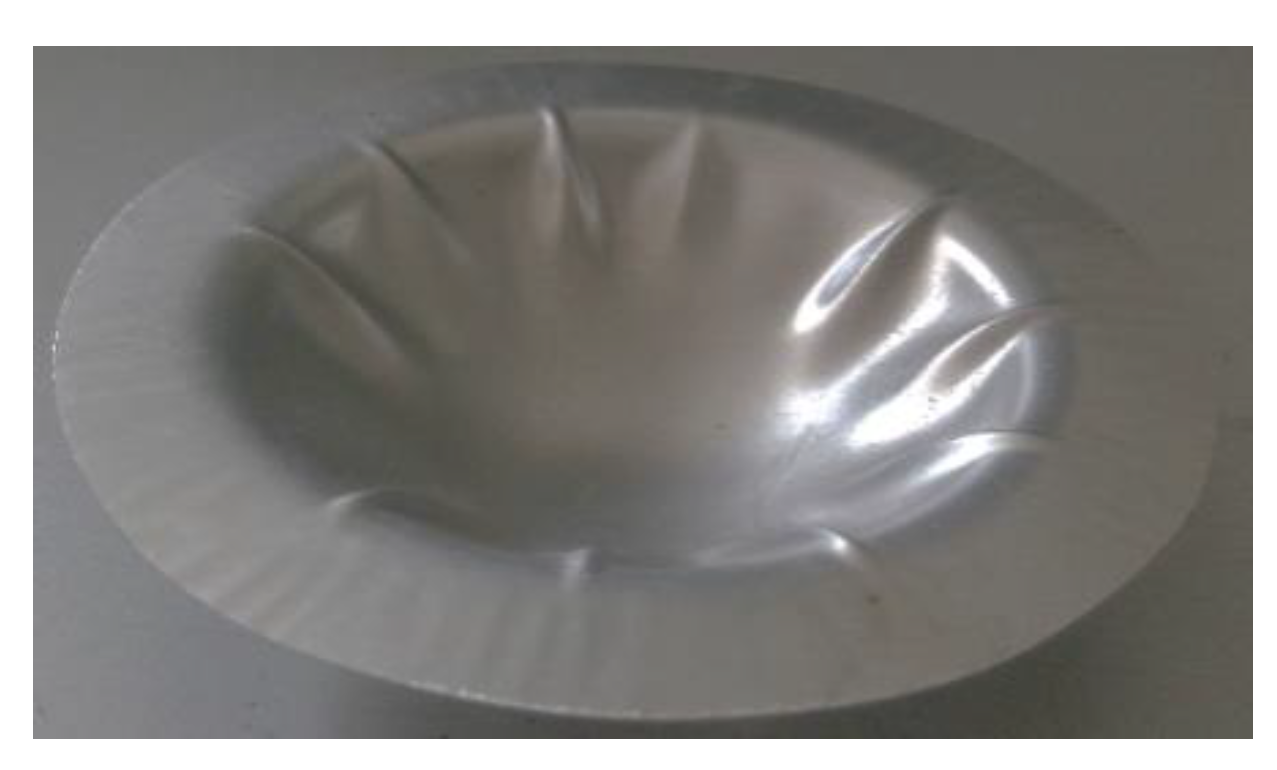
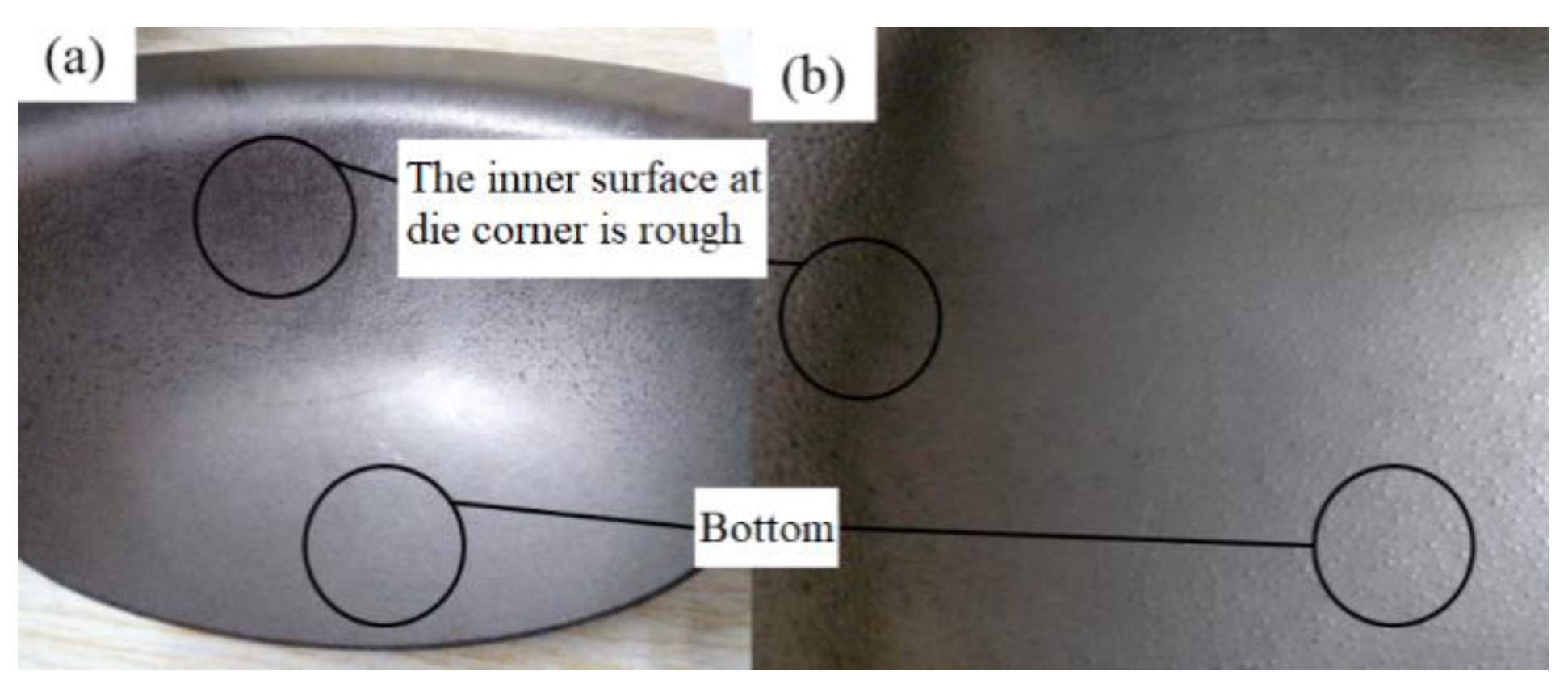

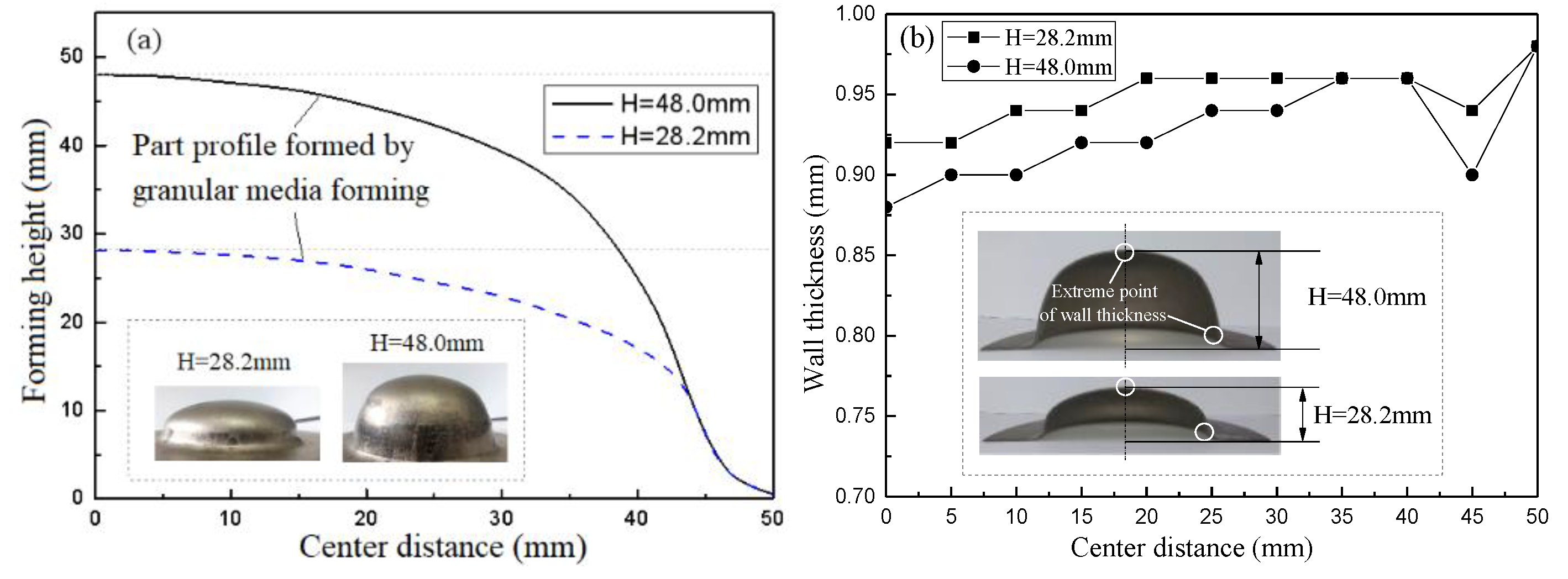




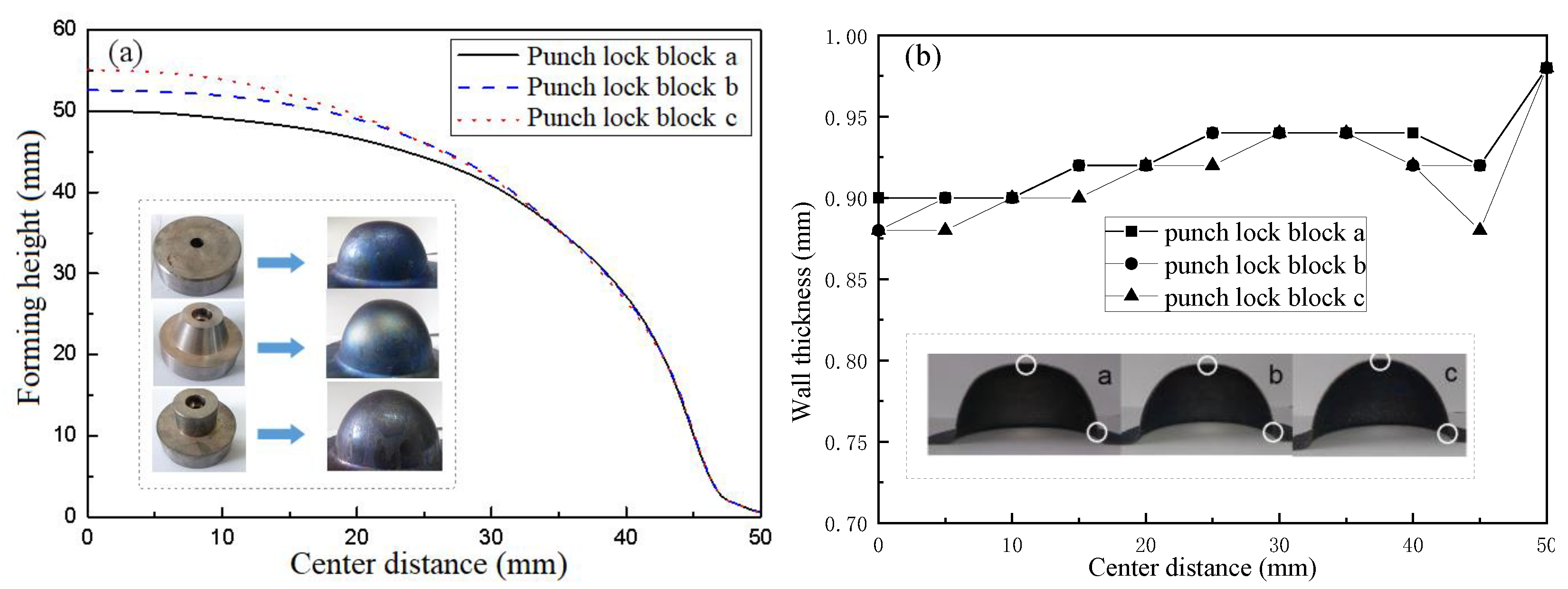
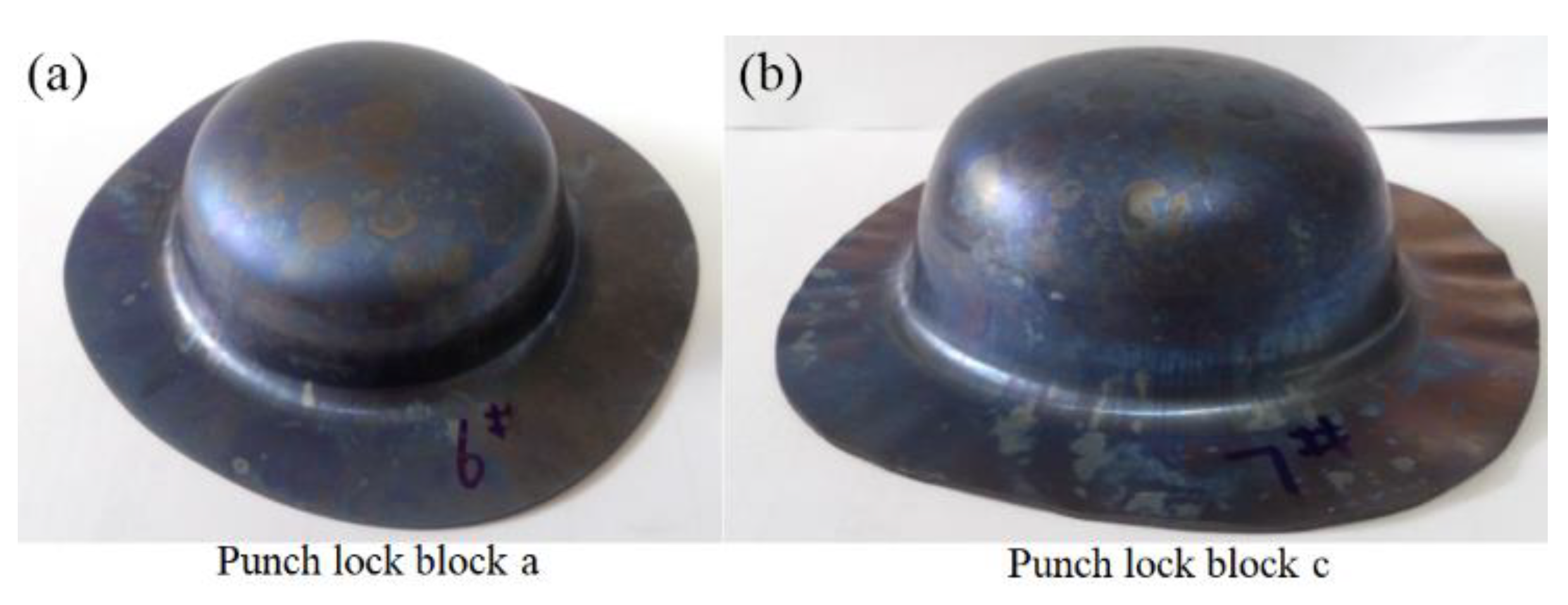

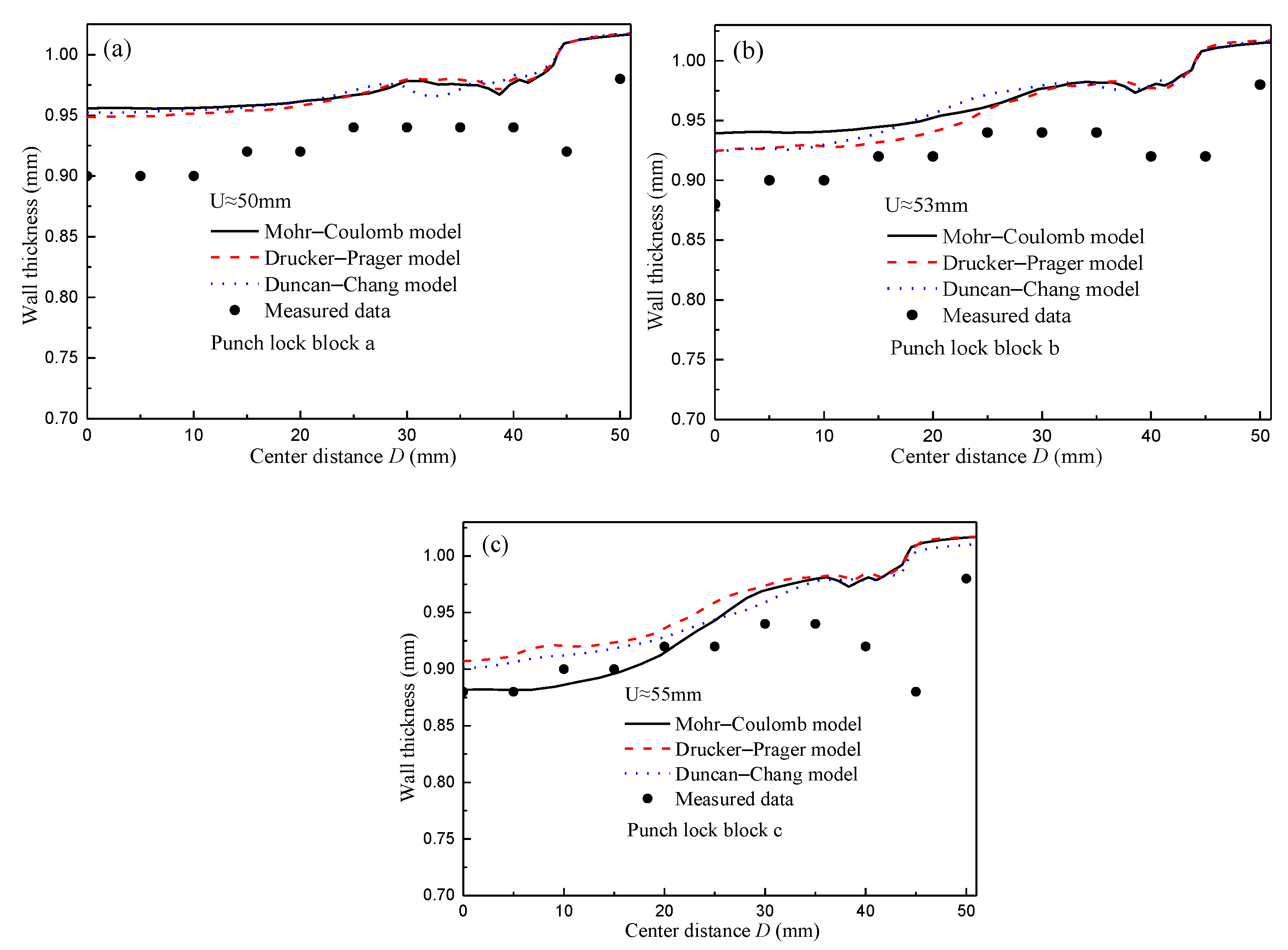

Publisher’s Note: MDPI stays neutral with regard to jurisdictional claims in published maps and institutional affiliations. |
© 2021 by the authors. Licensee MDPI, Basel, Switzerland. This article is an open access article distributed under the terms and conditions of the Creative Commons Attribution (CC BY) license (http://creativecommons.org/licenses/by/4.0/).
Share and Cite
Cai, G.; Fu, J.; Wu, C.; Liu, K.; Lang, L. Simulation and Experimental Investigation of Granular Medium Forming Technology on Titanium Alloy Sheet at 500 °C. Metals 2021, 11, 114. https://doi.org/10.3390/met11010114
Cai G, Fu J, Wu C, Liu K, Lang L. Simulation and Experimental Investigation of Granular Medium Forming Technology on Titanium Alloy Sheet at 500 °C. Metals. 2021; 11(1):114. https://doi.org/10.3390/met11010114
Chicago/Turabian StyleCai, Gaoshen, Jubo Fu, Chuanyu Wu, Kangning Liu, and Lihui Lang. 2021. "Simulation and Experimental Investigation of Granular Medium Forming Technology on Titanium Alloy Sheet at 500 °C" Metals 11, no. 1: 114. https://doi.org/10.3390/met11010114
APA StyleCai, G., Fu, J., Wu, C., Liu, K., & Lang, L. (2021). Simulation and Experimental Investigation of Granular Medium Forming Technology on Titanium Alloy Sheet at 500 °C. Metals, 11(1), 114. https://doi.org/10.3390/met11010114






